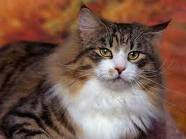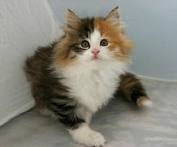The Norwegian Forest cats are known as ‘skogkatt’ or ‘skaukatt’ in Norway, ‘skog’ and ‘skau’ meaning forest in different dialects. It is believed that the Norwegian Forest cat did come out of the forests about 4000 years ago. Legend has it that travelled the world with the Vikings, protecting their grain stores on land as well as on the sea, and even left their progeny on the shores of America.
 |
| Norweigean Forest |
The Norwegian Forest Cat is a breed of domestic cat native to Northern Europe, and adapted to a very cold climate, with top coat of glossy, long, water-shedding hairs, and a woolly undercoat for insulation. Although this is uncertain, the breed's ancestors may have been short-haired cats brought to Norway by the Vikings around 1000 AD, and may also have included the long-haired Siberian and Turkish Angora. During World War II, the breed became nearly extinct until efforts by the Norwegian Forest Cat Club helped the breed by creating an official breeding program. It was not registered as a breed with the European Fédération Internationale Féline until the 1970s, when a local cat fancier, Carl-Fredrik Nordane, took notice of the breed and made efforts to register it. Currently, the Norwegian Forest Cat is very popular in Norway, Sweden, and France.
It is a strong, big cat, similar to the Maine Coon breed, with long legs, a bushy tail, and a sturdy body. The breed is very good at climbing, since they have strong claws. The lifespan is usually 14 to 16 years, though kidney and heart diseases have been reported in the breed. Specifically in this breed, complex rearrangements of glycogen branching enzyme (GBE1) can cause a perinatal hypoglycemic collapse and a late-juvenile-onset neuromuscular degeneration in glycogen storage disease type IV.
 |
| Norwegian Forest Cat |
Types of Norwegian Forest Cats
There are no specific types of Norwegian Forest Cats. However, they were not bred from any particular line and hence differ from line to line.
Physical Attributes of Norwegian Forest Cats
The Norwegian Forest Cats look like two different cats in summer and winter. Acclimatized to cold winters, they have a very thick, glorious coat during the cold months. In the spring, they shed their undercoat and look completely different. They also have fur in their ears, between toes and a large bushy tail to wrap around themselves. They are large cats, with males being larger than the females.
History
The Norwegian Forest Cat comes from natural selection to survive Norway's cold weather.Its ancestors may include black and white shorthair cats brought to Norway from Great Britain sometime after 1000 AD by the Vikings and longhaired cats brought to Norway by Crusaders. These cats would reproduce with farm and feral stock and would eventually evolve into the modern-day Norwegian Forest Cat.The Siberian and the Turkish Angora, longhaired cats from Russia and Turkey, respectively, are also possible ancestors of the breed.Norse legends refer to the Skogkatt as a "mountain-dwelling fairy cat with an ability to climb sheer rock faces that other cats could not manage."Since the Norwegian Forest Cat is the most adept climber,author Claire Bessant believes that the Skogkatt could be about the Norwegian Forest Cat.
Many people believe that the ancestors of the Norwegian Forest Cat served as mousers on Viking ships. They lived in the Norwegian forests for many centuries, but were later prized for their hunting skills and were used on Norwegian farms.Norwegian Forest Cats would continue acting as mousers at Norwegian farms until they were discovered in the early twentieth century by cat enthusiasts.
In 1938, the first Norwegian Forest Cat Club was formed. The club's movement to preserve the breed was interrupted by World War II (WWII). Due to cross-breeding with free-ranging domestic cats during WWII, the Norwegian Forest Cat became endangered and nearly extinct until the Norwegian Forest Cat Club helped the breed make a comeback by developing an official breeding program. Since the cat did not leave Norway until the 1970s, it was not registered as a breed in the Fédération Internationale Féline, a European federation of cat registries, until Carl-Fredrik Nordane, a local cat fancier, took notice of the breed, and made efforts to register it. The breed was registered in Europe by the 1970s, but was not recognized by the American Cat Fanciers Association until 1994.In 1978, it was recognized in Sweden,and in 1989, they were accepted as a breed in the United Kingdom.The Norwegian Forest Cat is very popular in Norway and Sweden. It is the fifth most popular breed in France since 2003, where there are about 400 to 500 births per year.
 |
| Norwegian Forest Cat Breeds |
Personality of Norwegian Forest Cats
They are playful, intelligent cats. They love human company and do not enjoy being left alone for long periods of time. They like the outdoors and are considered to be skilful hunters. They like high vantage points and are always climbing trees outside or bookshelves, cupboards, etc. inside the house. They are not high strung, but patient and great to have among children. They are considered to be loyal. They are also known to be highly responsive cats and good talkers.
Caring of Norwegian Forest Cats
The Norwegian Forest Cats do not need much maintenance except regular brushing during the spring and summer when they are shedding.
Norweigean Forest Kittens doing the trampoline Videos :
Breed description
The Norwegian Forest Cat is strongly built and is similar in size to the Maine Coon. The breed has a long, sturdy body, long legs, and a bushy and full tail. The coat consists of a long, glossy, thick and water-repellant top layer, and a woolly undercoat, and is thickest at the legs, chest, and head.
The profile of the breed is generally straight.The head is long, with an over-all shape similar to an equilateral triangle, a strong chin, and a muzzle of medium length; a square or round-shaped head is considered to be a defect. The eyes are almond shaped and oblique, and may be of any colour.The ears are large, wide at the base, high set, have a tufted top, are placed in the extension of the triangle formed by the head, and end with a tuft of hair like the ears of the lynx. All coat colors are accepted except chocolate and lilac and the dilutions fawn and cinnamon. Since the cats have very strong claws, they are very good climbers, and can even climb rocks.
The Norwegian Forest cat has a quiet voice but can develop a loud voice if kept in a house with a dog,but generally is talkative unless it was raised with a dog, it is then seemingly shy. It is good with people, being friendly and intelligent, but has a high amount of energy, and can be very demanding of attention.
 |
| Norweigean Forest Cat |
The Norwegian Forest cat has a quiet voice but can develop a loud voice if kept in a house with a dog,but generally is talkative unless it was raised with a dog, it is then seemingly shy. It is good with people, being friendly and intelligent, but has a high amount of energy, and can be very demanding of attention.
 |
| Norwegian Forest Cat Breeds |
Many cats can be primarily outdoor, where they can make swift and effective hunters, but the breed can also adapt to indoor life.They cost from $550 to $800, and usually live to be 14 to 16 years old. As they are heavy-boned and tall they require more food than most other domestic breeds.Males are considerably heavier and larger-boned than females.
Health issues
There have been kidney and heart diseases reported in the breed.[20] In an experiment directed by John C. Fyfea, Rebeccah L. Kurzhals, and others, it was concluded that a complex rearrangement in the breed's Glycogen branching enzyme (GBE1) can cause both a perinatal hypoglycemic collapse and a late-juvenile-onset neuromuscular degeneration in glycogen storage disease type IV in the breed.This disorder, while rare, can prove fatal to cats that have it.There are DNA test available for GSD IV, it is highly recommended (some cat associations obligate their Norwegian forest cat breeder member) to carry out the DNA test before using such animal for breeding.
Health issues
There have been kidney and heart diseases reported in the breed.[20] In an experiment directed by John C. Fyfea, Rebeccah L. Kurzhals, and others, it was concluded that a complex rearrangement in the breed's Glycogen branching enzyme (GBE1) can cause both a perinatal hypoglycemic collapse and a late-juvenile-onset neuromuscular degeneration in glycogen storage disease type IV in the breed.This disorder, while rare, can prove fatal to cats that have it.There are DNA test available for GSD IV, it is highly recommended (some cat associations obligate their Norwegian forest cat breeder member) to carry out the DNA test before using such animal for breeding.
PawPeds provide pedigree data base which come together with health programmes, through publishing each single cat's test result, to provide useful information for breeders who aim to breed healthy cat make a well informed breeding decision. The breed has also been known to suffer from hip dysplasia, which is a rare, partially hereditary disease of the hip joint.
 |
| Norwegian Forest Cat Kitten |
The breed, along with several other cat breeds, can be poisoned by things that are considered safe to humans, including alcoholic beverages, avocados, all forms of chocolate and coffee, macadamia nuts, onions, raisins, grapes, salt, and garlic. The breed is, along with most other cats, known to run the risk of getting Feline viral rhinotracheitis, Feline immunodeficiency virus,Rabies,H5N1,or several other diseases.






0 komentar:
Posting Komentar